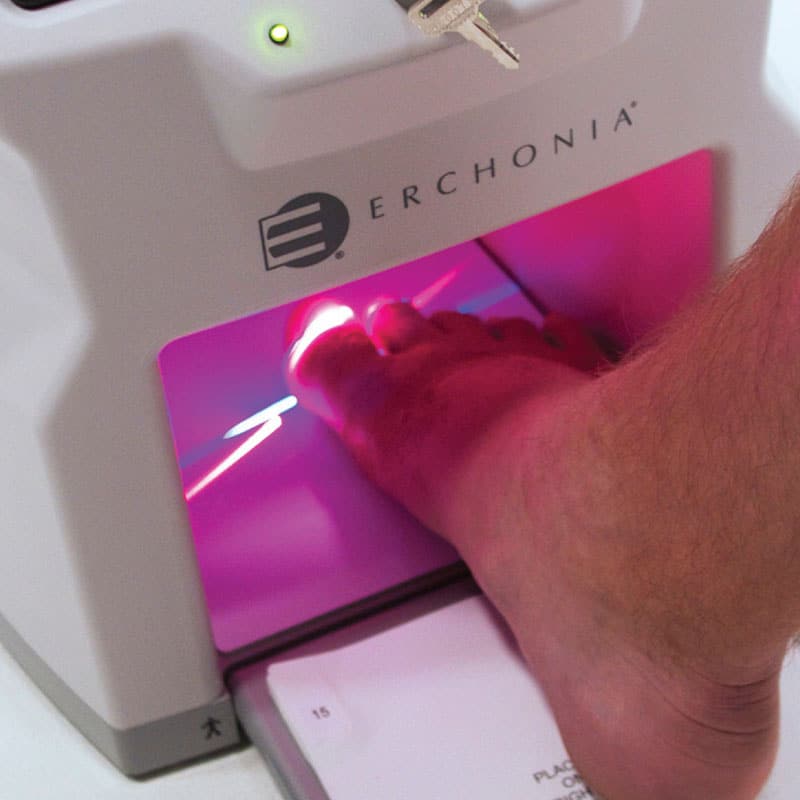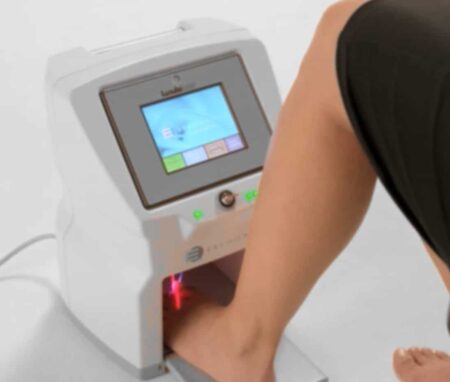Fungal nail infections are a common and frustrating problem affecting between 10% and 23% of people worldwide [1], a figure that skyrockets up to 50% in those aged 70 years and older [2]. And for those that have diabetes or are pregnant, the infection risk may be higher also due to the unique effects of each condition on the body – with treatment also potentially being more complicated due to the increased number of treatment contraindications or considerations that must be taken to ensure a person’s safety, as well as a good outcome for their fungal treatment efforts.
So what should you know if you’re treating patients that are living with diabetes or are pregnant and have fungal nail infections? Here’s a closer look, including which safe treatment options are available to give your patients the results they want.
Fungal Nail Infections And Diabetes [3]
Fungal nail infections, medically known as onychomycosis, pose additional concerns for those living with diabetes due to several interrelated risk factors. Diabetes is characterised by chronic hyperglycemia (high blood sugar levels) and is associated with various complications that increase the vulnerability to fungal infections. Firstly, hyperglycemia can impair the immune system’s response to infections, making those affected more susceptible to fungal colonisation and growth in the nails – simply meaning that they’re more vulnerable to picking up the infection in the first place. A compromised immune system fails to efficiently combat the fungal pathogens, allowing them to thrive and successfully infect the nail.
Then there are the diabetes-related complications like peripheral arterial disease and peripheral neuropathy, both of which contribute to the increased risk of fungal nail infections. Peripheral arterial disease results in poor blood circulation, particularly in the extremities (including the hands and feet), reducing the delivery of immune cells and nutrients necessary for fighting off infections. This compromised blood flow creates an ideal environment for fungal growth. Additionally, peripheral neuropathy, characterised by nerve damage, often leads to reduced sensation in the feet and toes – meaning that patients are unable to feel the sensations happening around them. This diminished ability to feel can make it challenging for affected individuals to detect small injuries or minor nail trauma, allowing fungi to penetrate the nails and establish infection unnoticed.
When it comes to treating fungal nail infections in diabetic patients, there are important considerations to keep in mind. The primary goal is always to effectively eliminate the infection while minimising any potential harm or complications. Systemic antifungal medications, such as tablets that are taken orally, should be approached with caution in diabetic patients. Some antifungal drugs, like azoles or allylamines (including the popular terbinafine), may also interact with diabetes medications, such as sulfonylureas or metformin, leading to changes in blood sugar levels. Therefore, systemic medications should be approached with great caution and monitoring – if used at all. Additionally, some systemic antifungal medications, such as terbinafine, can potentially interfere with the liver, which may pose a greater risk for individuals with diabetes, as they might already have compromised liver function.
Topical antifungal treatments, such as creams, gels, or nail lacquers, don’t pose the same risks as systemic medications as they are applied directly to the affected nails and are less likely to interact with diabetes medications or have systemic side effects. Any contraindications or risks should be clearly stated on the medication, but they are generally considered more safe to use in diabetes than systemic (oral) medications. Unfortunately, topical medications carry with them a different problem: poor effectiveness, as proven in the research.
- Efficacy rates of topical antifungals are relatively low, between 5.5% and 17.8% [4]. While this figure may increase up to 38% with regular manual debridement by podiatrists [5], this approach presents many logistical, financial and time barriers that make the prospect unattractive given it cannot guarantee a higher cure rate.
- Standard topical ointments cannot penetrate to reach all of the fungus due to the anatomy of the toenail. Specifically, the concentration of a topical ointment is reported to reduce by 1,000 times when moving from the outer to inner nail areas – and fungus is still very much present in the inner nail areas, and beneath the nail, as it spreads through the toenail [6].
This means that any treating practitioner should carefully weigh up whether it is worthwhile to offer these treatments in their clinics – or if there are other options that will yield better outcomes – and hence satisfaction rates.
Other popular treatment options include the use of laser therapy – an innovative treatment known for its safety profile, efficacy and ease of use. In the case of diabetes, hot lasers are typically contraindicated completely, given the risk of burns and the side effects of diabetes being unable to detect sensations – including heat. This poses a major risk of burns and subsequent ulcerations, which can be further complicated by impaired healing due to the circulatory impairments in diabetes. This is where cold laser is the only suitable laser option, posing none of the risks while offering all of the benefits.
Fungal Nail Infections And Pregnancy
Pregnancy brings with it much excitement but also many challenges – and the body’s response to fungal nail infections is one of these. The hormonal changes experienced during pregnancy, particularly increased estrogen levels, can affect the body’s immune response and create an environment conducive to fungal growth. Additionally, pregnant women may experience reduced circulation to the extremities, including the feet, which can impair the immune system’s ability to fight off infections. Furthermore, the presence of gestational diabetes, a temporary form of diabetes during pregnancy, can further increase the risk of fungal nail infections, through the same mechanisms we’ve mentioned above.
When it comes to treating fungal nail infections in pregnant women, special considerations are required to ensure the safety of both the mother and the baby. Much like in diabetes, topical antifungal treatments are typically preferred for pregnant women over systemic (oral) medications due to their localised action and minimal systemic absorption that reduces the potential risks to the developing baby. Yet, they still continue to yield poor success rates.
Systemic antifungal medications, which are taken orally or through injections, should generally be avoided during pregnancy unless the benefits outweigh the potential risks. The safety of systemic antifungal drugs in pregnancy has not been extensively studied, and there is limited information available. Certain systemic antifungal agents, such as fluconazole, have been associated with an increased risk of adverse fetal outcomes when used in high doses or for prolonged durations during the first trimester. Therefore, caution is advised when considering recommending systemic antifungal therapy during pregnancy.
Much like with diabetes, hot laser is also largely contraindicated in pregnancy, and is not offered to pregnant women in most clinics due to the risks. This is where cold laser is also a viable option – posing no risks to mother or baby with an excellent safety profile, no adverse effects, and fantastic success rates.
Lunula Laser: Safe And Effective For Diabetics And Pregnant Women
Lunula cold laser has changed the lives (and nail health) of many pregnant women and those with diabetes by offering a safe and effective solution for even severe fungal nail infections. Lunula uses cool wavelengths of light to produce its fungicidal effects. The device is box-like, where the patient sits back and inserts their foot into the device. From here, the laser utilises a dual-diode approach, where two heat-free laser beams of 405nm and 635nm respectively operate in unison to target the fungal cells while fortifying the body’s natural defence mechanisms, each with their own specific mechanism of action. The blue wavelength (405nm) significantly weakens the outer wall of the fungal cells by causing irreversible damage while the red (635nm) wavelength strengthens the body’s immune cells to act on the fungus, which improves blood flow to the area to accelerate the treatment process. The rotating lasers run for 12 minutes per foot, acting on the entire foot and all toenails, making this a very comfortable process for those having the treatment.
With one of the most important questions being how effective the laser is, studies show the efficacy results for cold laser range from demonstrating an 89% clear nail increase with a 67% treatment success rate [7], to clinical cure and mycological cure rates of 70% and 95% respectively. These figures rise to 90% and 95% by 12 months, with 100% of study participants having new unaffected nail growth [8]. Studies conducted using strict protocols by the laser manufacturers have confirmed individual success rates to be as high as 86% at week 12, extending to 99% by week 48 [9].
When examining any laser results, it’s important to differentiate between the degree of severity of nails affected, as many patients will present with extreme fungal severities, and some hot laser studies we observed excluded heavily affected nails. One Lunula study, where on average 81% of the toenail was affected by fungus (denoting a severe infection), showed that 63.6% of toenails reached full clearance [10]. Two audits completed by clinics using the cold laser in patient management have reported success rates of 84-87% [11] and 89% [12] over 12-18 months. Cold laser also demonstrated excellent patient satisfaction rates, including in a study of 320 patients using the laser that resulted in a 93% satisfaction rate [13].
The simplest summary of the above is that the Lunula laser is proven to be highly effective whether or not your patients have diabetes or are pregnant, and it’s comfortable, easy and completely safe too, with no known side effects.
You can learn more about cold laser, including expected profitability from bringing the device into your clinic, and a full review of its research and evidence, by contacting RehaCare on 1300 653 522
- [1]: https://www.ncbi.nlm.nih.gov/pmc/articles/PMC4047123/
- [2]: https://www1.racgp.org.au/ajgp/2019/october/superficial-fungal-infections
- [3]: https://www.ncbi.nlm.nih.gov/pmc/articles/PMC7565282/
- [4]: https://www.ncbi.nlm.nih.gov/pmc/articles/PMC6600855/
- [5]: https://www1.racgp.org.au/ajgp/2019/october/superficial-fungal-infections
- [6]: https://onlinelibrary.wiley.com/doi/full/10.1111/bjd.13358
- [7]: https://www.ncbi.nlm.nih.gov/pmc/articles/PMC5479474
- [8]: https://www.peertechzpublications.com/articles/IJDCR-7-140.php
- [9]: https://www.coldlasernailclinic.nz/wp-content/uploads/2018/03/ERCHONIA-LUNULA-Toenail-Onychomycosis-Clinical-Study-Results-Report-FDA-3.docx
- [10]: https://www.podiatrym.com/pdf/2017/1/Tumolo117web.pdf
- [11]: https://www.compleetfeet.co.uk/lunula-laser-fungal-nail-audit-201617/
- [12]: https://www.podiatrym.com/pdf/2017/1/Tumolo117web.pdf
- [13]: https://www.opnassociation.ca/wp-content/uploads/2019/09/Sullivan_Erchonia-Laser-Therapy-in-the-Treatment-of-Onychomycosis-Preliminary-Report_Podiatry-Review-Vol-71.2_03_14.pdf



